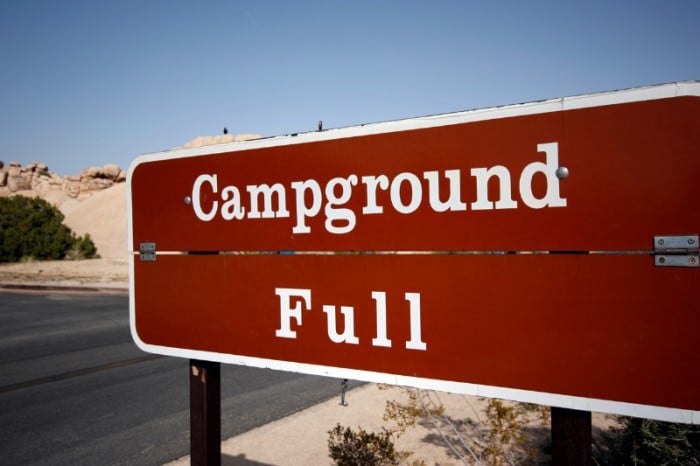Campgrounds close at certain times of the year, but some people still manage to camp in them. Is it illegal? Or are there ways to still camp?
Camping at a closed campground depends on the ranger station, the reason for closing, and permits (if any). You may be able to camp if the campground is only “out of service” or partially closed. But you’ll be restricted from camping if natural hazards are present.
Some ranger districts allow you to use their campgrounds despite being closed. However, there are many reasons why you’ll likely not want to do so.
Reasons Why You CAN Camp at a Closed Campground
You can and cannot camp at a closed campground for several reasons, but mainly involve the availability of operations and safety.
1. Limited Operations Only
Campgrounds close during the off-season. This means there are no operations and maintenance services.
Technically, campgrounds you can camp in with limited operations are deemed “out of service” campgrounds.
But “closed” campgrounds are truly closed and should not be camped in.
Unofficially, you can call the campground of your choice to see if they will still welcome you. Keep in mind that if they do, some facilities may not be open, including the toilet.
This also means you must ensure to clean up your mess (as you should) because there may be no staff on site. The gates of these campgrounds will also likely be closed.
So, you will have to find parking nearby, assuming you’re driving there. You’ll likely have to walk into the campground – fee free.

2. Special Tribal Permit
Camping is prohibited on National Forest campgrounds outside the operating season. However, tribal members may be able to do so with a special tribal permit due to treaty rights.
With this, the length of stay on some campgrounds and their fees are waived. Tribal members are permitted to gather wild plants and other flora.
Depending on the National Forest, this could be up to 16 days or longer.
3. Partial Closures
Sometimes, not all of the campground is closed. There may be partial closures due to maintenance, weather, or emergencies.
Little Rock District, for example, shows on their website the partial closures affecting different campgrounds.
The list also contains open and closed campgrounds, but you can check back periodically to see if there are any changes.
Because the campground only closes specific areas, you can access the rest of the campsite.
A map of the closed and open areas can help you protect yourself and avoid any campground violations.
Reasons Why You CAN’T Camp at a Closed Campground
If you do choose to camp regardless, there are consequences you ought to prepare for. However, there are alternatives when you have the itch to go on an outdoor adventure.
1. Alerts or Warnings
The USDA Forest Service lists the closed campgrounds and the reasons on their website. This is typically due to alerts or warnings regarding emergencies.
Some of these alerts include:
Wildfire or Black Fire Alerts
A black fire emergency closure is sometimes announced in national forests. This protects the public during black fire activities, including active wildfires and other fire dangers.
Black fire is a massive wildfire that burns in New Mexico. It’s part of the wildfire season and has become the second-largest fire in the state’s history.
Gila National Forest is one of the areas under fire restrictions due to the event. Roads and trails will also be closed. As of June 14, 2022, the black fire has been contained at 47%.
Bear-Human Interactions
Black bears sometimes come into the camps to seek food and waste. If there is an increased sighting, alerts will be made in the nearby areas to protect both bears and humans.
The USDA reminds us that “a fed bear is a dead bear.”
Trail Closure
Sometimes, bridges and trails get closed due to maintenance or safety concerns. It could be due to tree felling, rock slips, flooding, etc.
The national forest involved will typically provide a map of the affected area and when the problem is expected to be resolved.
2. Reservations are Required
Sometimes, a campground is closed because you need reservations to get in. Little Dune 1 Campsite is an example.
These campgrounds prohibit walk-ins due to the number of people visiting, especially during peak seasons.
A reservation system offers a more relaxed, uncrowded, and peaceful camping experience. Campgrounds also tend to be understaffed.
Other campgrounds close entirely if this is the case. Maintaining a reservation system will also help regulate the number of people to how much their current staff can handle.

3. Flooding or Undesirable Weather
Campgrounds close due to flooding, windstorms, or other bad weather. The priority of the operators is public health and safety.
You can check with your local authorities if the campground you plan to go to will be closed, in addition to any news you hear of bad weather.
Usually, during winter, some campgrounds will close because lakes and trails have ice and snow and can’t be maintained.
Water supply also tends to be cut off during this season.
4. Pandemic
Because of the recent COVID-19 pandemic, nearly all campgrounds closed their operations. This includes RV parks, national parks, and even military campgrounds.
You can visit local websites for updated operation schedules. You can use the National Park Service’s website to locate information about a specific park.
What Happens If You Camp At a Closed Campground?
As mentioned earlier, some ranger districts still allow people to camp. This is especially true if you’ll only stay a night or two.
However, what if they don’t allow it and you decide to go camping anyway? The least of your worries would be that they kindly ask you to leave.
You might end up with a fine or jail time in the worst-case scenario.
According to USDA, violations of federal regulations for national forests can result in fines of $5,000 for individuals and $10,000 for organizations.
Imprisonment can last for up to six months. You can receive both punishments depending on the gravity of the violation.
On the other hand, if a closed campground opens its gates for you (as some do), you get to enjoy camping for free.
You’ll just be roughing it on your own, which shouldn’t be a problem.
Alternatives to a Closed Campground
There are alternatives if you’ve made the call and can’t camp in your chosen campgrounds. You can still head on an outdoor adventure in your RV or at a different campsite.
AllStays has a directory of campgrounds in the US and Canada. You can view their maps and filter different price ranges for your trip.
Their maps include details about the campground website, the nearest weather station report, and even reviews from other campers.
You can also choose from their list of state parks, RV parks, city parks, lakes, etc.
Similarly, you can use the WikiCamps USA app. It also has a large database of campgrounds and RV parks you’ll find useful for any outdoor adventure.
As a bonus, they also have a trip planner and camping checklist you can use in preparation.
The Bottomline
You can camp at closed campgrounds if your chosen ranger station permits it. However, closed campgrounds are generally off-limits during the off-season.
Many people camp on these grounds, despite the restrictions.
If you plan to do so, you’ll want to ensure that the place is free from hazards and that the reason for their closing would not be detrimental to your stay.
You’ll also want to be aware of the specific consequences of any violations you might make.
